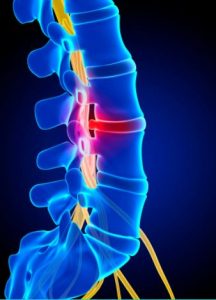Summer’s over, schools ‘started’ and the autumnal equinox is among us. God forbid your allergies cause a cough or sneeze under that mask. The air is getting cooler and the days are getting shorter as we begin to finalize this trip around the sun, but this one’s been a doozy.
One constant this year has been herniated discs. Herniated disc can cause back pain, neck pain, shoulder pain, arm & leg pain, foot & ankle problems, numbness, burring, tingling, weakness, 
Why does the disc cause so many symptoms? The disc is the jelly stuff between the vertebra. There is not a lot of space for much else however remember your nerves are there too. When a disc is bulging or herniating the jelly protrudes out and bothers the nerve. The symptoms you will feel will be based on how bothered the nerve is and what nerve is being affected.
What can be done to help a herniated disc? In these cases, spinal decompression that uses computerized sensors to perform small stretching actions on the spine and promote healing. It can be uniquely effective by creating a scenario in which the disc tissue is able to move back into place and heal, not just alleviating the pain. Think putting the jelly back inside a jelly donut.
How does it work? The therapy itself works to stretch the spine, using a spinal decompression table to create negative pressure space, essentially a vacuum, within the disc to allow disc fluid to move back into place. This creates an environment in which the disc can receive more nutrients and therefore heal itself. Healing herniated discs is possible but it’s not a quick fix.
Not to be the COVID guy, but…we’ve seen way more bad herniated discs lately not directly because of COVID; but because all the lifestyle changes and impediments to care brought on by COVID. The moral of this story-get up and move and don’t be afraid to come in.
